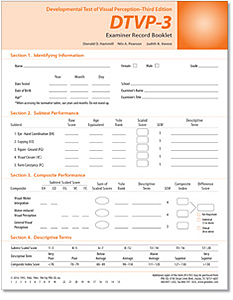

The reliability of the various subtests and index scores indicates that the DTVP-A will be sensitive to improvement over the course of treatment. Normed through age 75, the DTVP-A has sufficient floor or easy items to allow accurate assessment of even individuals with severe TBI and other neurologically impaired individuals.

The DTVP-A is especially useful in the evaluation of the neuropsychological integrity of TBI and stroke patients where right-hemisphere function may be at issue. It can be administered by psychologists, neuropsychologists, occupational therapists, physical therapists, regular and special educators, and diagnosticians who are interested in examining the visual-perceptual status and visual-motor integration skills of adolescents and adults. The DTVP-A is the latest test based on the work of Marianne Frostig. The battery has empirically established reliability and validity. Subtests were assigned to a particular composite on the basis of the amount of motor ability required by their formats.ĬOMPLETE DTVP-3 KIT INCLUDES: Examiner’s Manual, Picture Book, 25 Response Booklets, 25 Examiner Record Booklets, and a Copying scoring template, all in a sturdy storage box.The DTVP-A is a battery of six subtests that measure different but interrelated visual-perceptual and visual-motor abilities. The targeted figure will have a different size, position, and/or shade, and it may be hidden in a distracting background.ĭTVP-3 Composites The results of the five DTVP-3 subtests are combined to form three composites: Motor-reduced Visual Perception, Visual-Motor Integration, and General Visual Perception (combination of motor-reduced and motor-enhanced subtests).
#DTVP ASSESSMENT SERIES#
Children are shown a stimulus figure and asked to find it in a series of figures. In order to complete the match, children have to mentally supply the missing parts of the figures in the series. Children are shown a stimulus figure and asked to select the exact figure from a series of figures that have been incompletely drawn. Children are shown stimulus figures and asked to find as many of the figures as they can on a page where the figures are hidden in a complex, confusing background. Subsequent figures are increasingly complex. The figure serves as a model for the drawing. Children are shown a simple figure and asked to draw it on a piece of paper. Children are required to draw precise straight or curved lines in accordance with visual boundaries. The overall look of the test was updatedĭTVP-3 Subtests The DTVP-3 has five subtests.The study of item bias has been expanded.Numerous eligibility and validity studies, including studies of the test’s sensitivity, specificity, and ROC/AUC, have been provided.The composite scores have no floor or ceiling effects.Norms were extended upward to age 12 years, 11 months.New normative data were collected in 20.90 or above for the composites for all age groups its scores are validated by many studies its norms are based on a large (N = 1,035), representative sample it yields scores for both visual perception (no motor response) and visual-motor integration ability and it is shown to be unbiased relative to race, gender, and handedness. Of all the tests of visual perception and visual-motor integration, the DTVP-3 is unique in that its scores are reliable at the. The DTVP-3 is the most recent revision of Marianne Frostig's popular Developmental Test of Visual Perception. Please download, complete and submit this publisher-required form with your order.


 0 kommentar(er)
0 kommentar(er)
